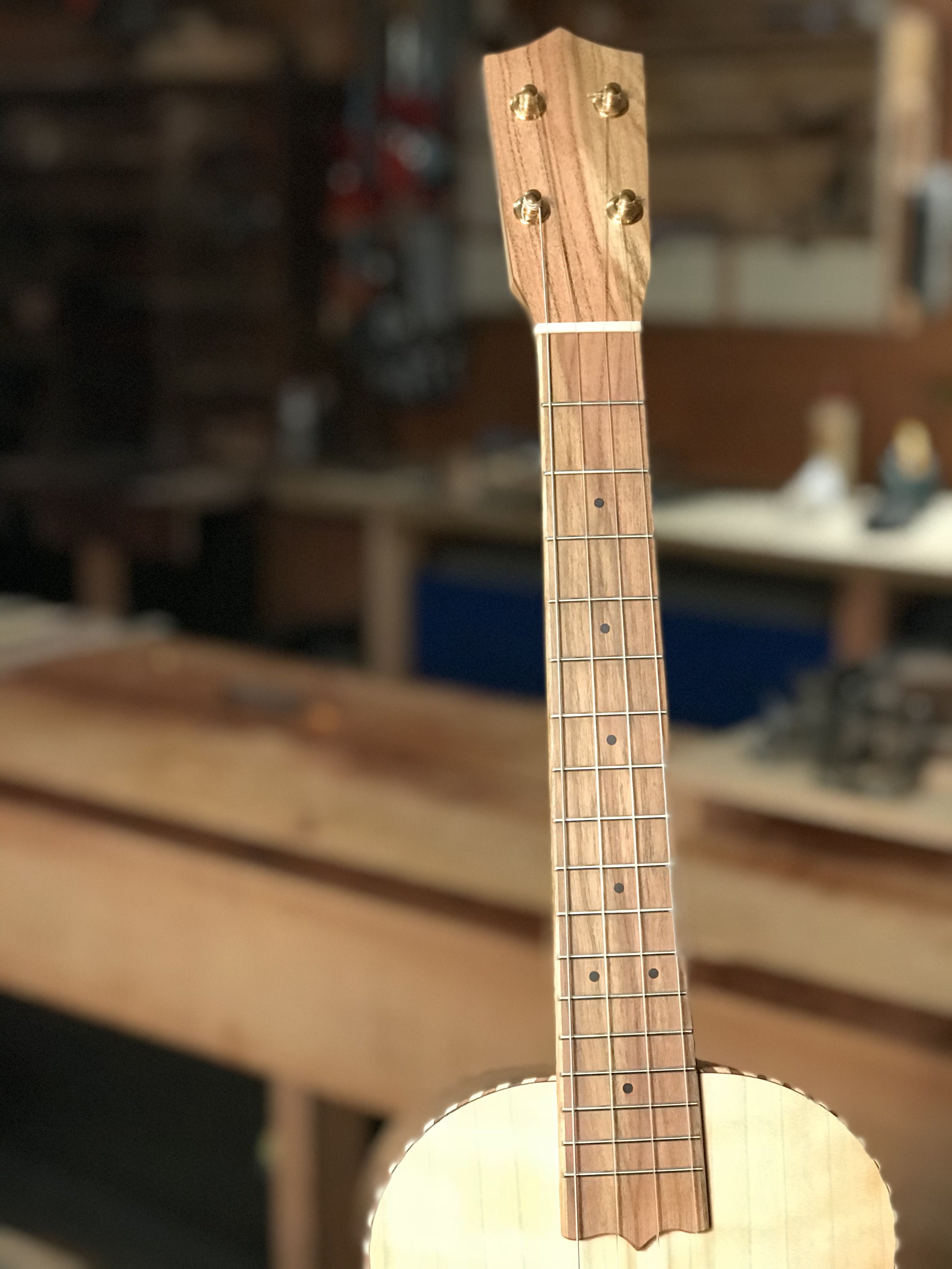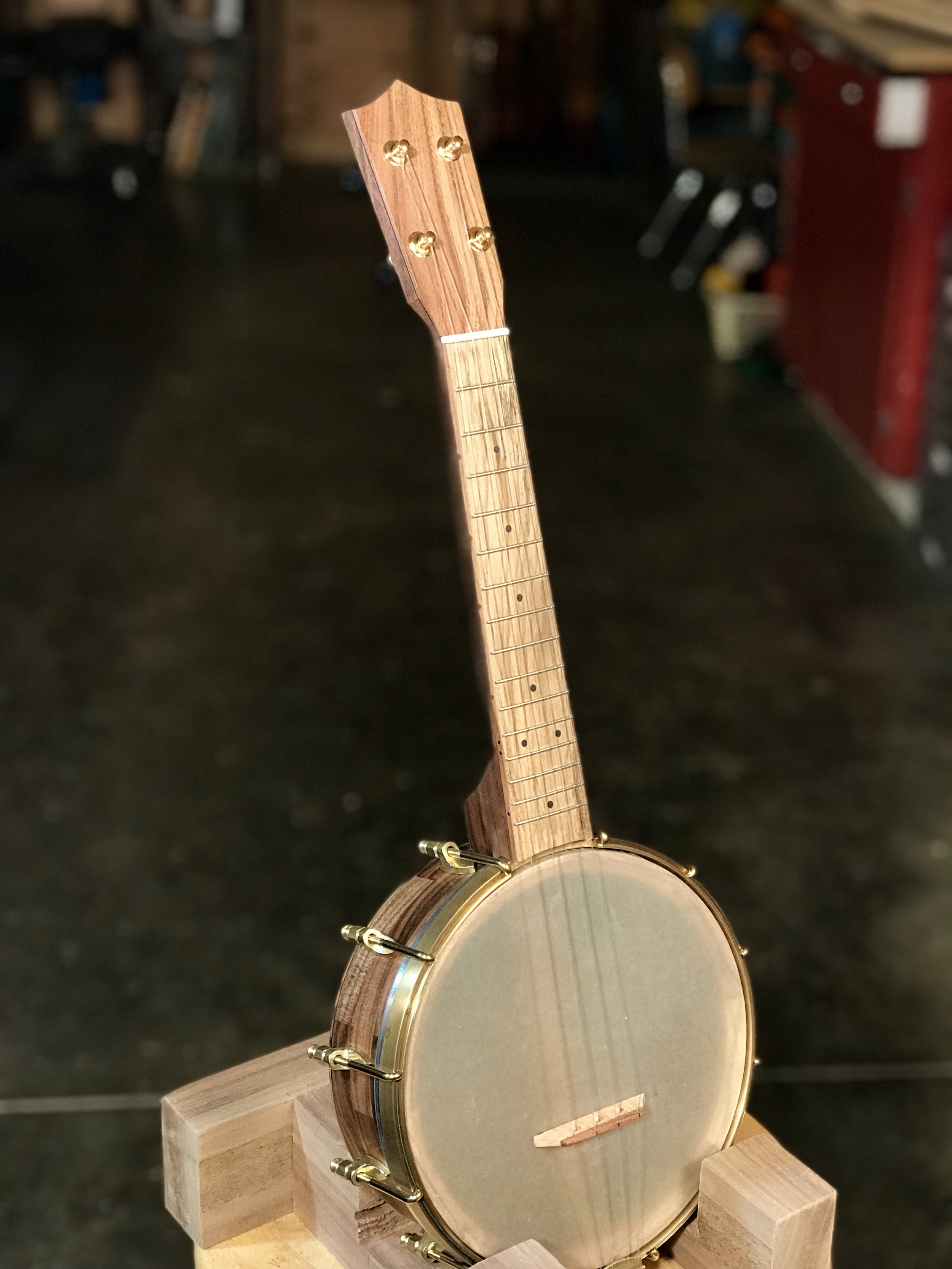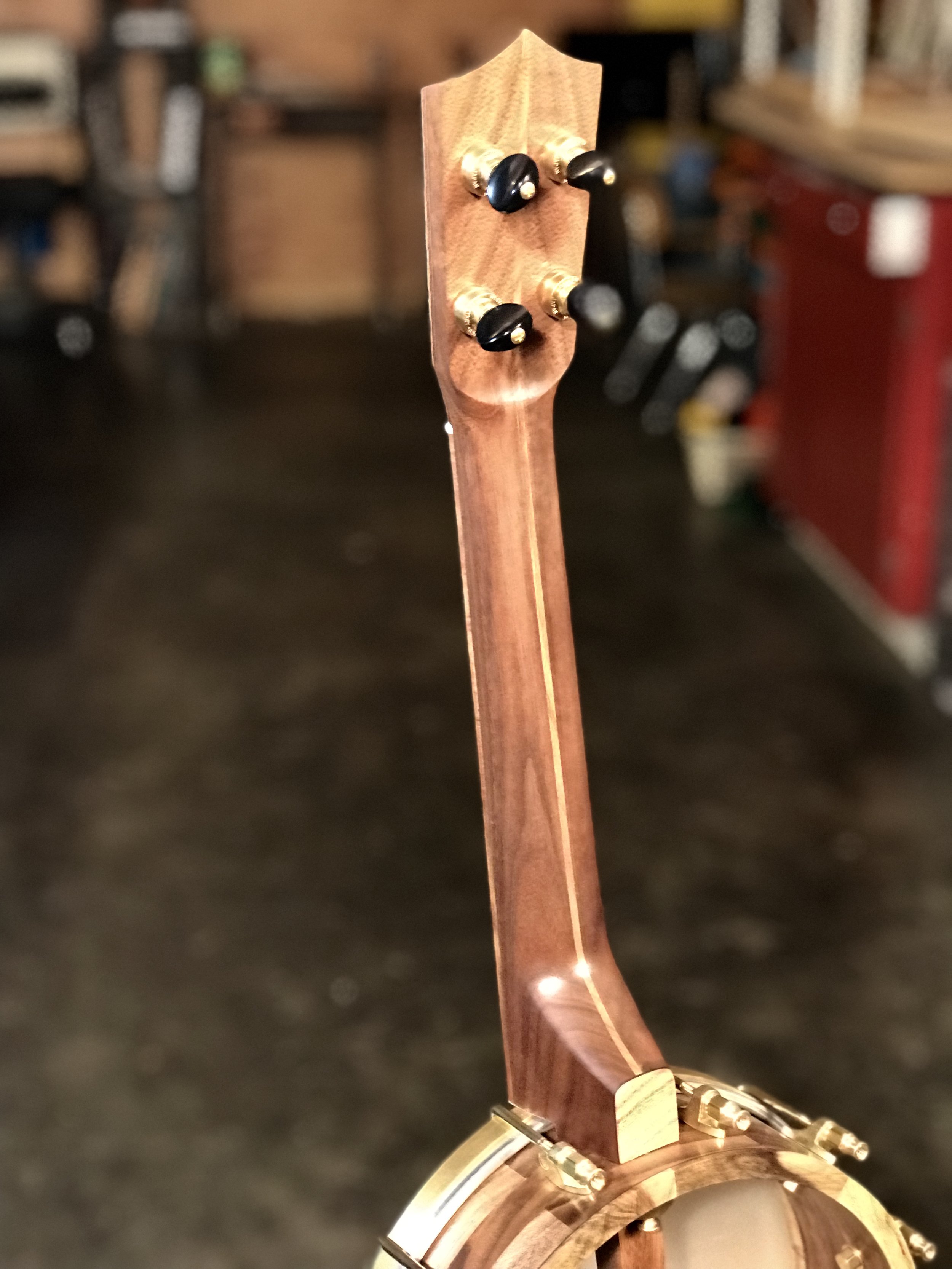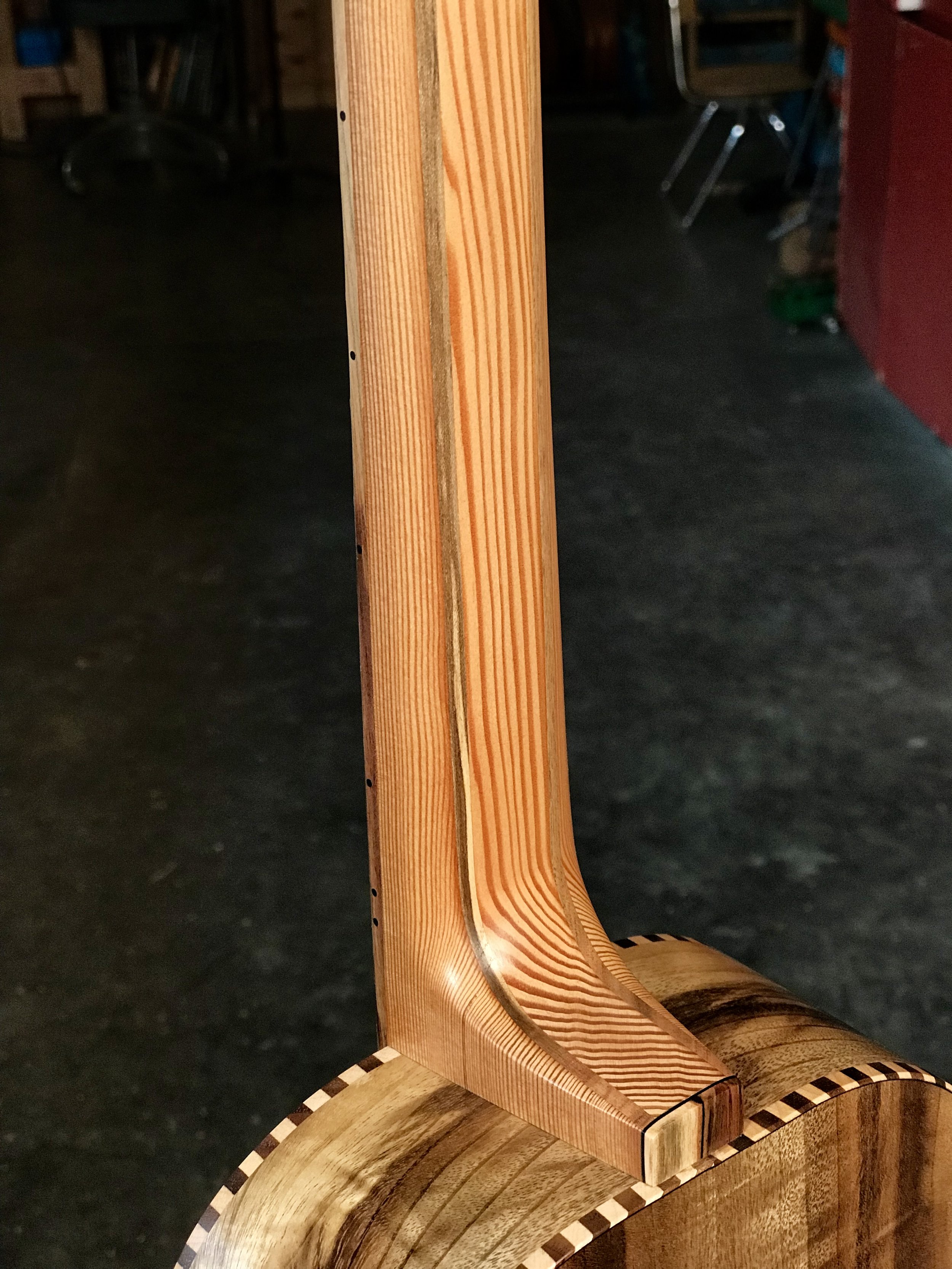Living in a rural smallish town, we bump into a fair bit of the barter economy. Banjo lessons for food truck lunches, graphic design for hard cider, woodworking for childcare, etc…In this case I get to make a banjo to help pay for the amazing wood I get from Kevin and Irwin at woodfromthewest.com. I used a unique pistachio fretboard paired with some amazing two color curly maple from Zena Forest Products in Salem, another favorite supplier. This is the last board from this tree, begged from Ben when I went to Zena this summer for the old woodworking machines meetup. I have it in the lower open G tuning, which seems to work best with maple. I am told Irwin likes to play with members of his family, who play guitar and banjo. I send this little banjo as my contribution from one family business to another. Here’s to many more years of woodworking and music!
#316- Master Grade Myrtle, Pistachio and Fir Alto Ukulele
When you have a set of myrtle like this, it seems best to just get out of the way and let it shine. I paired it with simple two-color pistachio binding and an understated pistachio fretboard and headplate. I didn’t want to distract from the mastergrade myrtle which was given to me from Char from Mya-Moe before she retired. It has an interesting rising match of the four top and back plates highlighting a couple of small knots as they emerge from the quilted figure. It’s voice is rich and meaningful but not too loud/harsh. It’s got something important to say but will not yell to be heard. If you miss out on it’s voice then you are talking too loud. Be quiet and notice this elegant/functional object, you won’t regret stopping to listen.
#320- Walnut and Pistachio Concert Banjo Ukulele
I often think about the difference between art and craft and artist vs craftsman(person). I feel that there is cultural assumption that an artist makes one of a kind works, fueled by flights of fancy and the whims of a tortured soul. Anyone who has been in the trenches of making a living in the arts will tell you that it is the opposite. The Rolling Stones play “Satisfaction” every night, Gordon Ramsay makes risotto all the time and there are 57 known works in Picasso’s blue period. This repetition is what leads to the gradual refinements and developments that define the evolution of art/craft. The walnut, concert banjo uke seems to be my current repetitive task, forcing me to reach to perfection and innovation at the same time. For this one, I laid out the neck differently due to the dimensions of the original boards from the Carpenter Ant stash in Portland. It required two pieces of pistachio down the middle of the walnut to build up enough width. I also had fun playing with the swirling fretboard and headplate from Pistachio. This instrument is both a repeat performance and one of a kind, just how I like it.
#314- Port Orford Cedar, Pistachio and Fir Tenor Ukulele
I was having a grumpy day in the shop when an un-expected detail saved the day for me: I noticed that the upper left corner of this fir neck had a streak of darker red in it. As the ukulele progressed, I couldn’t stop seeing red in the upper left: head plate, back, fretboard. Although I often layout woods improvisationally, maybe some details are a happy accident or maybe some decisions are made subconsciously. Either way, I am happy with with this one and that I drew me out of a grumpy spell. Port Orford Cedar from the Oregon Coast, Pistachio from California orchards and a wide grain fir neck from my friend’s land on Vashon Island. It is solid and sturdy but the cedar top gives it a punch and zip. Ready for years of music making!
#319- Koa, Pistachio and Fir Tenor Ukulele
You know that I have been sticking to more local woods since launching Beansprout, but Koa and Mahogany are so foundational to ukulele history that I can’t ignore them. However, I am always looking for the best ecological and economical way to use these “tropical” woods, sticking to salvaged sources and trusted suppliers. This particular Koa set comes from Bruce at Notable Woods and was sold as a “second” or flawed set. I find it’s flaws/freckles/dimples completely charming and can’t believe it ever made it onto the “B” grade pile. Add to it a one of a kind wavy pistachio fingerboard from California Orchards and a knotty old growth Douglas Fir neck and I am smitten. I hope you are too.
#318- Spruce and Walnut Tenor Ukulele For Westwind
Out on the Oregon coast there is a special place called Camp Westwind. On a peninsula between the Salmon river and the ocean, it is a place of rugged beauty and old growth forests, but I know it best as a place of peaceful minds, grateful hearts and musical joy. We have been lucky enough to teach music there for Tunes In The Dunes several times and it always has been a highlight of our year. Three years ago, their site manager, Scotty, started saving wood for me that he cut and milled from downed trees on the Westwind property. Last year I made a couple of banjo ukes from Westwind wood, this time I put together this all spruce and walnut tenor ukulele. It is slated to be auctioned at Tunes In the Dunes to benefit Westwind. If you want one like it in the future, I will happily build you one and donate part of the profits.
#313- Spruce and Walnut Alto Ukulele
Yes, I made up the name "Alto" ukulele. Just a whimsical design I dreamed up in an attempt to create the ideal small uke. I wanted an instrument that had the cuteness and plink of a classic soprano but a little more depth of tone and a slightly larger size. The traditional concert ukulele always seems to be just a lack luster tenor, so I thought the alto might be the solution. I admit it, I did it just cause I wanted to. But that is the prerogative of the artist. We do things that we dream about and hope someone else cares enough to buy it! I have to admit that at the end of the demo video I actually got a little choked up hearing and feeling this idea come to fruition.
This Alto uses a beautiful figured Engelmann spruce top and Oregon walnut from Goby for the back and sides. The dark pistachio comes from California orchards. The fir neck comes from my friend Cath's property on Vashon Island, WA. May it sing like I dreamed it would.
#311- Spruce and Pistachio Baritone Ukulele
The baritone ukulele is a bit of a strange beast. Ukulele folks want it in order to lower their available range and depth and guitar folks are puzzled why they only have four strings. Most baritone ukuleles loose the sparkle and clarity of a uke tuned gcea and you end up with a dark, quiet, muddy sound. The goal then, should be to create an instrument that gives the uke player more range, keeps the crisp tone that an ukulele needs and makes the guitar players jealous. Deep and rich but bright and punchy. This combo of spruce and pistachio nails it, in my opinion. The spruce is salvaged old growth from Alaska Specialty Woods and the pistachio is grafted orchard wood from woodfromthewest.com.
#315- Walnut and Pistachio Concert Banjo Ukulele
After I sold my last banjo uke while on tour in New Zealand, I threw this one together to finish the tour season. Plain walnut from the Carpenter Ant stash and pistachio from California Orchards. Neat and serviceable, ready to make music.
#308- Curly Port Orford Cedar, Pistachio and Fir Tenor Ukulele
First, just the bill of materials:
-Curly Port Orford Cedar top salvaged and milled by woodfromthewest.com
-Pistachio from California Orchards
-Douglas fir neck salvaged from floor boards from a store in The Dalles, OR.
-Bone nut and saddle, GHS strings, K&K pickup and Gotoh tuners.
All this adds up to a really solid and resonant tenor ukulele. The extra weight of the pistachio makes it feel solid, but the light Port Orford Cedar top makes it sing and vibrate. I feel when I play it that it can handle anything I can give it, something a lighter uke can't always do for me. The materials make for a tidy and unique aesthetic, but I made sure to include one nail hole in the neck from the original floor boards. Just a small reminder of our true imperfection when compared to our high expectations and lofty goals. Just like the music it will make, it is destined to be both flawed and beautiful!
#307- Walnut, Fir and Pistachio tenor ukulele
This one was really fun for me to put together. It made me think about the difference between art and craft, luthier and craftsman, folk art and fine art, perfection and practice, etc...It might not come through to the player who strums it, but it was on my mind when I made it and maybe some small part of these musings get shut in the case before Nicole mails it out. The top is old growth Douglas Fir that matches my new baritone uke below. The back and sides are Oregon walnut from Goby in Portland and the pistachio is from California orchards. The neck is some unique wide grain fir from my friend Cath from Vashon Island, WA. I bought my big bandsaw and jointer from her and she sent me back with a stash of Fir from the trees on her property. I love how the wide grain fir makes for a unique texture in the left hand due to the hardness differences between the hard and soft rings. It plays easy, sounds loud and true, is made from materials I believe in and looks unique and beautiful. Feeling lucky today.
#309- Grafted Walnut, Douglas Fir and Pistachio Baritone Ukulele
For the last few years I have been playing baritone ukulele more than the other sizes. The lower pitch is a compliment to Nicole's tenor uke strumming, but I have to have make sure that my baritone ukes have the crisp brightness needed to play leads and melodies. This old growth Douglas Fir top seems to be the right balance for me: as loud as spruce but with a dusty earthiness unique to Fir. The walnut on the back is grafted with two different species for root and fruit stock, a common practice in orchards. I got this walnut set from Kevin from woodfromthewest.com and I admit that I saved it just to show off a little bit as it is so unique and beautiful. Here is more info on the grafted variety: https://cdnc.ucr.edu/cgi-bin/cdnc?a=d&d=PRP19060707.2.2 Of course, I had to use my favorite walnut and maple rope binding. Add on geared brass Gotoh tuners, a K&K pickup, bone nut and saddle and GHS strings to make it stage ready. Look for this one soon in several videos as I work on our next ukulele book.
#312- Maple and Pistachio Mini Five String Banjo
Every once in a while a piece of pistachio just leaps off the shelf and yells "pick me, pick me!" I have never seen a fretboard like this one and don't expect I ever will. I paired it with a subtle bird's eye maple neck and a rim made of three different boards of maple for a unique look. All of the maple comes from the Carpenter Ant stash in Portland, the Pistachio comes from California Orchards. The customer wanted this in the standard banjo tuning, so I put heavier gauge strings on it and tuned it down to gdgbd. Even with the short scale, this tuning works although it is a pretty mellow sound, which is why some folks seem to like it. Either way, this one is ready to head to Colorado and make some music!
#303- Master grade myrtle tenor ukulele
I like to call Myrtle "Oregon's Koa," because it looks as beautiful as Hawaiian Koa and sounds great too. I like to think that if the ukulele originated here they would have picked myrtle as the traditional ukulele wood! This fancy myrtle comes from near Pistol River, OR from woodfromthewest.com. The old growth Douglas Fir neck comes from floor boards from The Dalles, OR and the pistachio fretboard and trim is from California orchards. This one is a great example of why the myrtle tenor became our bread and butter at Mya-Moe: it's the perfect combination of sound and looks!
#310 Walnut and Pistachio Concert Banjo Ukulele
I found some curly two color curly walnut from the carpenter ant stash in Portland and paired it with some swirly reddish pistachio from California orchards for this little guy. I like how the closer you look at it, the more small details you see in the wood grain! The walnut concert banjo uke has turned into one of our most popular models and it's easy to see why. The concert scale is the right balance in your lap for the 8" rim and the warmth of the walnut cuts some of the brightness of the banjo. A great combo.
#297- Bearclaw spruce and mastergrade Myrtle Tenor Ukulele
I have to say, I think this customer picked a really classy configuration for her uke. The simple pistachio binding sets off the fancy spruce and myrtle well and the salvaged Douglas fir neck is a great way for some wabi-sabi to sneak in. The spruce top gives a rich warm sound with plenty of volume and with the geared Gotoh tuners and K&K pickup, it is ready for the stage. The spruce is salvaged Alaskan bearclaw Sitka spruce, provided by Alaska Specialty Woods. The Mastergrade Oregon myrtle and California Pistachio come from woodfromthewest.com. The Douglas fir was salvaged from a shop in The Dalles, OR.
#306- Walnut and Pistachio Concert Banjo Ukulele
This customer asked for two things: a wild fretboard and walnut from the Carpenter Ant stash. I said: "No Problem." Business is easy when you attract like minded folks who already believe in what you do. As a reminder, the Carpenter Ant stash is a lifetime wood stash of the father of a friend. He spent years as a cabinet maker and set aside his favorite pieces as they came into the shop. They have allowed me access to the wood in order to see his precious collection turned into musical tools. The wild pistachio fretboard and headplate come from California orchards and I love how no two are alike. Oh yeah, how does it sound? Well, it's one of those that seems to vibrate in my lap and throw the sound out but manages to stay sweet. I hope Leigh likes it as much as I do!
#305- Walnut and Pistachio Tenor Banjo Ukulele
It really is strange to me that every single one of these has it's own voice. I probably am the only one who can hear the difference, as they all sound like a Beansprout after all. But, I love the process of getting to know each of their voices and shipping them off to you for the real musical experience to happen. I take a pile of wood, brass and plastic, do 1000 tiny, mundane operations and out comes this unique musical tool. I'll never get sick of this. This walnut is from the Carpenter Ant stash in Portland and the pistachio is from California orchards. It is for a guy named Tom who has the important job of really getting to know this one.
#304- Walnut and Pistachio Five String Banjo
Dark Oregon walnut, reddish California pistachio, raw brass hardware from Brooks Masten and Fluorocarbon strings instead of steel. All this makes a rich and mellow instrument that still has some punch to it. This is for my friend and mentor Marianne, who already plays ukulele and has been wanting to learn banjo for a while. She wasn't so sure when she came to pick it up, but after three notes of Angeline the Baker she was grinning. Hooked.
#296 Spruce and Maple Tenor Ukulele
This tenor ukulele is the first customer order for our new line of ukes and I am very pleased with how it turned out. The spruce top comes from a stash of spruce cut for a dulcimer maker in the 1960's which I inherited from a friend. Because of it's age, it already has a great golden brown color and sounds old too. The maple is from the Carpenter Ant stash in Portland. The Douglas fir neck comes from floorboards salvaged from The Dalles, OR. The pistachio comes from California Orchards.
The customer also plays banjo and wanted a uke that could hang with his friends other acoustic instruments. I thought this wood combo would give the volume that I needed, but I also worked hard to make sure it's voice was balanced, not piercing or shrill. I think it worked out great.
































































































































